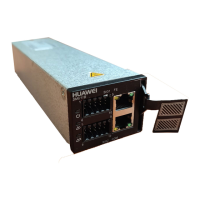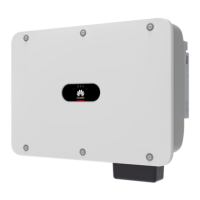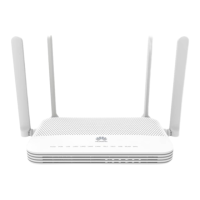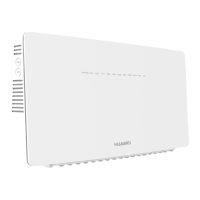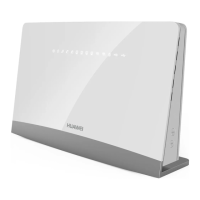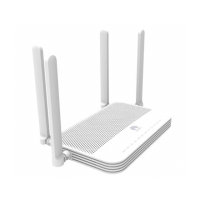Do you have a question about the Huawei SmartAX MA5800-X7 and is the answer not in the manual?
Describes the target audience for the document, focusing on hardware installation engineers.
Defines symbols used in the document for safety and information, like DANGER, WARNING, NOTICE, CAUTION, NOTE.
Details changes in Issue 04, adding cabinet with routed cables (AC).
Details changes in Issue 03, including third-party cabinets and layout optimization.
Details changes in Issue 02, adding subrack installation in an IEC cabinet.
Marks the first release of the document.
Guidelines for preventing damage to sensitive components from static electricity using ESD gloves and wrist straps.
Recommendations for cable tie placement and cutting to ensure neatness and prevent injury.
Instructions for attaching labels and identification plates to cables, specifying orientation and placement.
Lists and illustrates essential tools and meters needed for the installation process.
Details the 6U height, fan tray location, and mounting ear options (IEC/ETSI) for the subrack.
Specifies dustproof cabinets and depth requirements (min 300mm) for cable routing space.
Requirements for cabinet doors, grounding, and power distribution, including over-current protection.
Guidelines for ensuring adequate heat dissipation, air inlet, and ventilation in cabinets.
Advises reserving 4U space above and below the subrack for optimal heat dissipation and component impact.
Step-by-step guide to install the subrack in an ETSI cabinet, including mounting ears and cable managers.
Step-by-step guide to install the subrack in an IEC cabinet, including cable managers and mounting.
Illustrates cable routing for DC power in an N63E-22 cabinet, applicable to IEC cabinets/racks.
Illustrates cable routing for AC power in an N66E-22 cabinet, detailing floating nut positions and cable holes.
Instructions for connecting PGND and power cables, including safety precautions and connection points.
Details how to route clock cables, connecting BITS IN0/IN1 to clock source and BITS OUT to lower level clock.
Guide for connecting network cables to the maintenance terminal or transmission unit.
Instructions for routing trunk cables, showing connection points to the DDF and binding positions.
Safe handling and routing of optical fibers for P2P boards, including bending radius and bundling.
Safe handling and routing of optical fibers for GPON boards, specifying bending radius and connector types.
Methods for routing upstream optical fibers, either together with downstream or separately.
A checklist of items to observe and verify after installation, covering chassis, slots, cables, and connectors.
Procedures for checking input voltage ranges and the normal status of the fan tray before powering on.
Describes the target audience for the document, focusing on hardware installation engineers.
Defines symbols used in the document for safety and information, like DANGER, WARNING, NOTICE, CAUTION, NOTE.
Details changes in Issue 04, adding cabinet with routed cables (AC).
Details changes in Issue 03, including third-party cabinets and layout optimization.
Details changes in Issue 02, adding subrack installation in an IEC cabinet.
Marks the first release of the document.
Guidelines for preventing damage to sensitive components from static electricity using ESD gloves and wrist straps.
Recommendations for cable tie placement and cutting to ensure neatness and prevent injury.
Instructions for attaching labels and identification plates to cables, specifying orientation and placement.
Lists and illustrates essential tools and meters needed for the installation process.
Details the 6U height, fan tray location, and mounting ear options (IEC/ETSI) for the subrack.
Specifies dustproof cabinets and depth requirements (min 300mm) for cable routing space.
Requirements for cabinet doors, grounding, and power distribution, including over-current protection.
Guidelines for ensuring adequate heat dissipation, air inlet, and ventilation in cabinets.
Advises reserving 4U space above and below the subrack for optimal heat dissipation and component impact.
Step-by-step guide to install the subrack in an ETSI cabinet, including mounting ears and cable managers.
Step-by-step guide to install the subrack in an IEC cabinet, including cable managers and mounting.
Illustrates cable routing for DC power in an N63E-22 cabinet, applicable to IEC cabinets/racks.
Illustrates cable routing for AC power in an N66E-22 cabinet, detailing floating nut positions and cable holes.
Instructions for connecting PGND and power cables, including safety precautions and connection points.
Details how to route clock cables, connecting BITS IN0/IN1 to clock source and BITS OUT to lower level clock.
Guide for connecting network cables to the maintenance terminal or transmission unit.
Instructions for routing trunk cables, showing connection points to the DDF and binding positions.
Safe handling and routing of optical fibers for P2P boards, including bending radius and bundling.
Safe handling and routing of optical fibers for GPON boards, specifying bending radius and connector types.
Methods for routing upstream optical fibers, either together with downstream or separately.
A checklist of items to observe and verify after installation, covering chassis, slots, cables, and connectors.
Procedures for checking input voltage ranges and the normal status of the fan tray before powering on.
| Product Type | OLT |
|---|---|
| Service Ports | PON ports |
| Power Supply | -48 V DC |
| Control Boards | Dual control board redundancy |
| Supported Standards | ITU-T G.984, ITU-T G.987, IEEE 802.3ah |
| Power Supply Backup | Yes |
